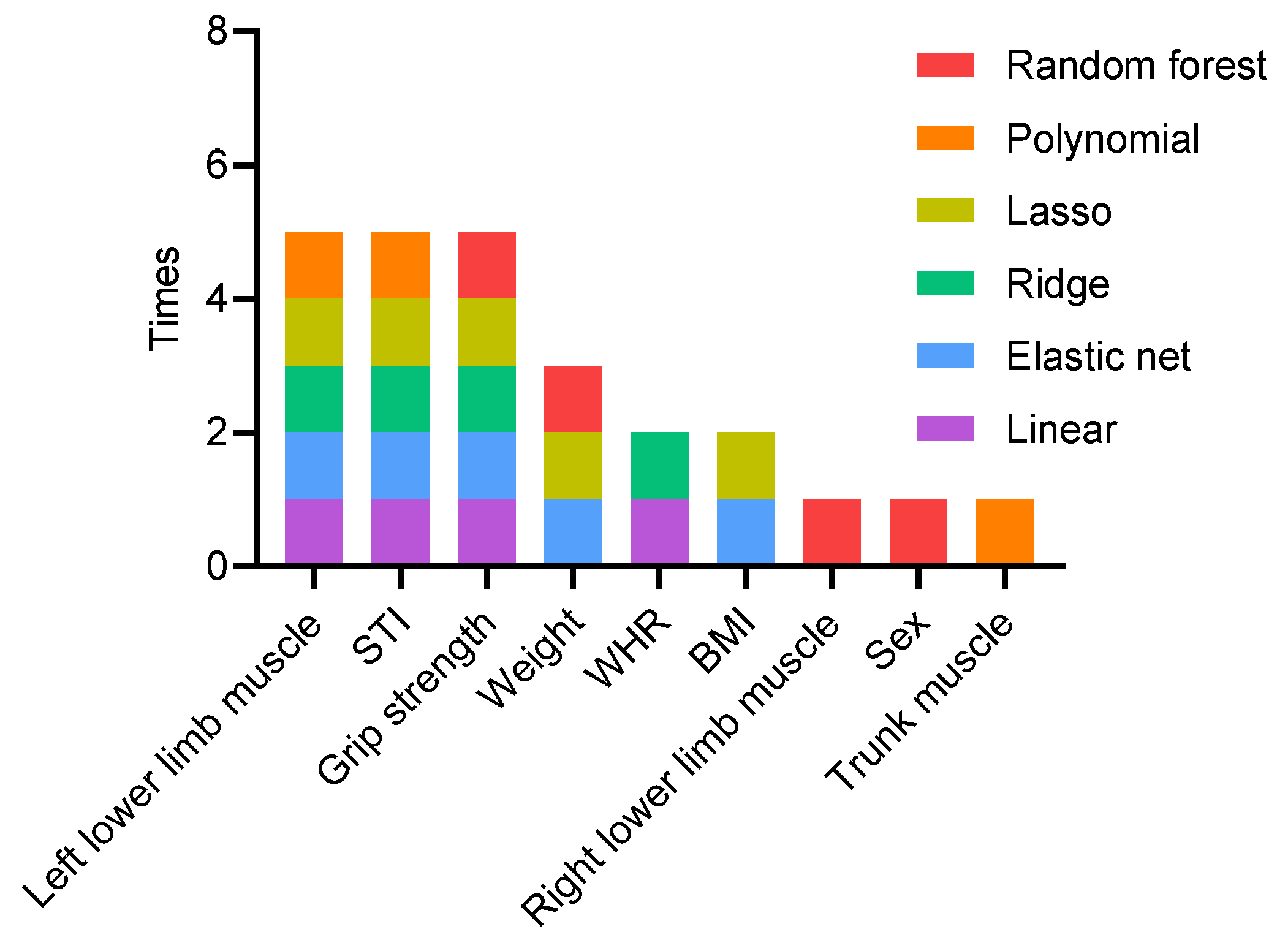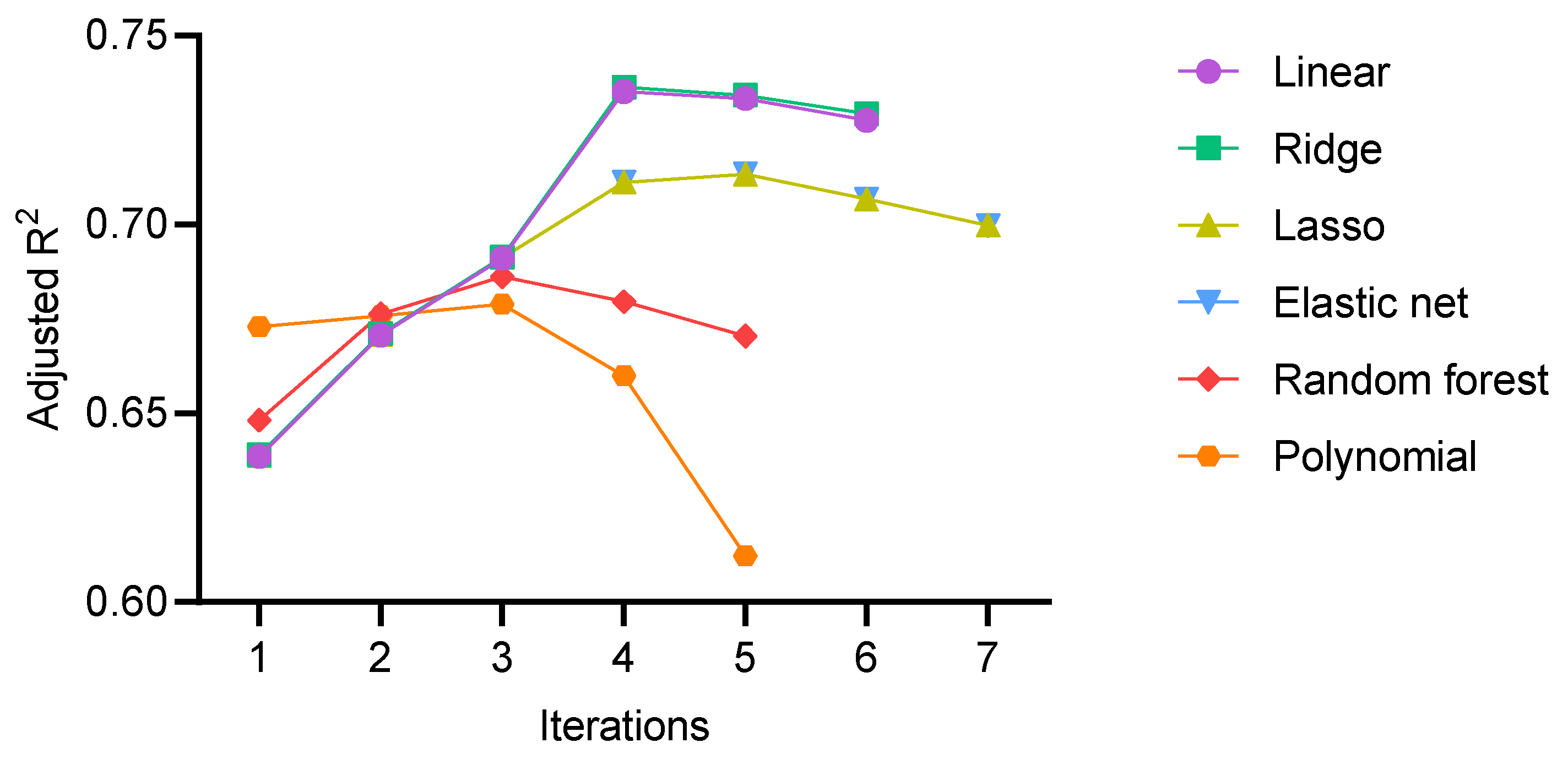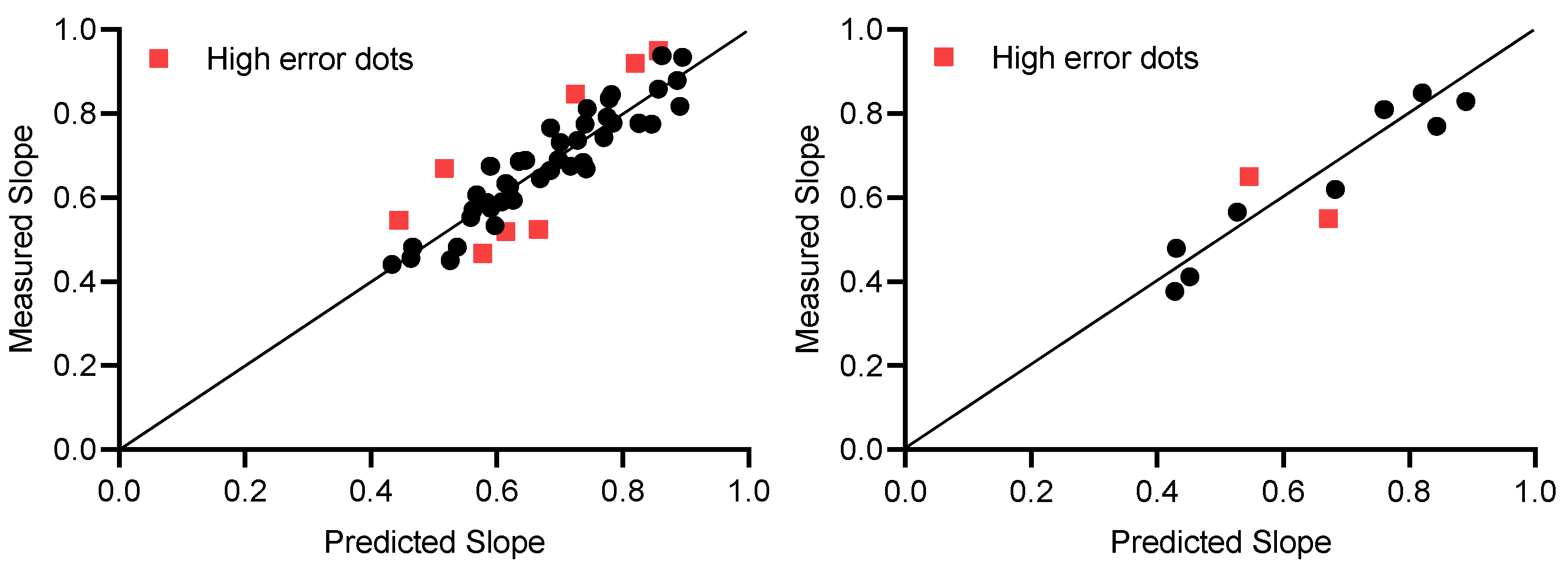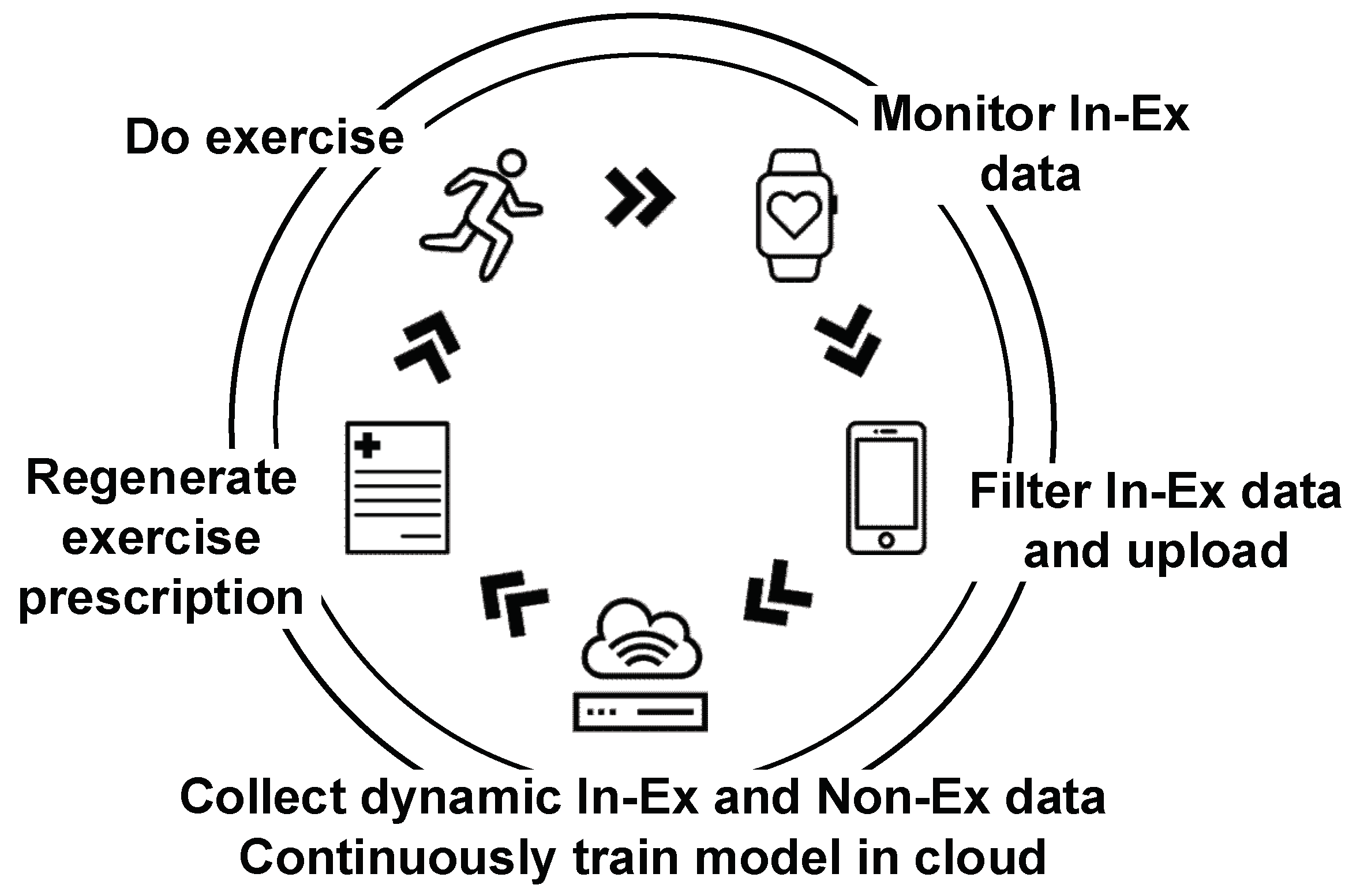Achieve Personalized Exercise Intensity through an Intelligent System and Cycling Equipment: A Machine Learning Approach
Abstract
Featured Application
Abstract
1. Introduction
2. Materials and Methods
2.1. Participants
2.2. Experimental Protocol
2.3. Measured Features and Statistical Analysis
2.4. Algorithm Design
- Select the i-th feature in the feature matrix as the j-th feature of the regression model for machine learning (i and j both start at 1).
- Perform multiple regression models to predict the slope S.
- Use the leave-one-out method to verify and save the adjusted R2 value of the model.
- Select another feature (i + 1) from the feature matrix and then perform steps 1–3 until all of the features in the feature matrix have been traversed.
- Select the feature with the best predictive effect, and then delete the selected features from the feature matrix. Add another feature (j + 1) of the regression model and repeat steps 1–4.
- Continue to add new features until the adjusted R2 value of the model drops for two consecutive time; then, the iteration is terminated.
3. Results
3.1. Linear Regression Model of Heart Rate and Wattage
3.2. Feature Matrix and Regression Algorithm Analysis
3.2.1. Model Selection and Feature Analysis
3.2.2. Ridge Regression Model Analysis
4. Discussion
5. Conclusions
Author Contributions
Funding
Acknowledgments
Conflicts of Interest
References
- Garber, C.E.; Blissmer, B.; Deschenes, M.R.; Franklin, B.A.; Lamonte, M.J.; Lee, I.M.; Nieman, D.C.; Swain, D.P. Amer Coll Sports M: Quantity and Quality of Exercise for Developing and Maintaining Cardiorespiratory, Musculoskeletal, and Neuromotor Fitness in Apparently Healthy Adults: Guidance for Prescribing Exercise. Med. Sci. Sports Exerc. 2011, 43, 1334–1359. [Google Scholar] [CrossRef] [PubMed]
- Thompson, P.D.; Arena, R.; Riebe, D.; Pescatello, L.S. ACSM’s New Preparticipation Health Screening Recommendations from ACSM’s Guidelines for Exercise Testing and Prescription, Ninth Edition. Curr. Sports Med. Rep. 2013, 12, 215–217. [Google Scholar] [CrossRef] [PubMed]
- Butte, N.F.; Watson, K.B.; Ridley, K.; Zakeri, I.F.; McMurray, R.G.; Pfeiffer, K.A.; Crouter, S.E.; Herrmann, S.D.; Bassett, D.R.; Long, A.; et al. A Youth Compendium of Physical Activities. Med. Sci. Sports Exerc. 2018, 50, 246–256. [Google Scholar] [CrossRef] [PubMed]
- Ainsworth, B.E.; Haskell, W.L.; Herrmann, S.D.; Meckes, N.; Bassett, D.R.; Tudor-Locke, C.; Greer, J.L.; Vezina, J.; Whitt-Glover, M.C.; Leon, A.S. 2011 Compendium of Physical Activities. Med. Sci. Sports Exerc. 2011, 43, 1575–1581. [Google Scholar] [CrossRef] [PubMed]
- Mezzani, A.; Hamm, L.F.; Jones, A.M.; E McBride, P.; Moholdt, T.; A Stone, J.; Urhausen, A.; A Williams, M. Aerobic exercise intensity assessment and prescription in cardiac rehabilitation: A joint position statement of the European Association for Cardiovascular Prevention and Rehabilitation, the American Association of Cardiovascular and Pulmonary Rehabilitation and the Canadian Association of Cardiac Rehabilitation. Eur. J. Prev. Cardiol. 2012, 20, 442–467. [Google Scholar] [PubMed]
- Swain, D.P. Energy cost calculations for exercise prescription: An update. Sports Med. 2000, 30, 17–22. [Google Scholar] [CrossRef] [PubMed]
- Ainsworth, B.E.; Haskell, W.L.; Leon, A.S.; Jacobs, D.R.; Montoye, H.J.; Sallis, J.F.; Paffenbarger, R.S. Compendium of physical activities–classification of energy costs of human physical activities. Med. Sci. Sports Exerc. 1993, 25, 71–80. [Google Scholar] [CrossRef] [PubMed]
- Ainsworth, B.E.; Haskell, W.L.; Whitt, M.C.; Irwin, M.L.; Swartz, A.M.; Strath, S.J.; O’Brien, W.L.; Bassett, D.R.; Schmitz, K.H.; O Emplaincourt, P.; et al. Compendium of Physical Activities: An update of activity codes and MET intensities. Med. Sci. Sports Exerc. 2000, 32, S498–S516. [Google Scholar] [CrossRef] [PubMed]
- Howley, E.T. Type of activity: Resistance, aerobic and leisure versus occupational physical activity. Med. Sci. Sports Exerc. 2001, 33, S364–S369. [Google Scholar] [CrossRef]
- Nelson, M.E.; Rejeski, W.J.; Blair, S.N.; Duncan, P.W.; Judge, J.O.; King, A.C.; Macera, C.A.; Castaneda-Sceppa, C. Physical Activity and Public Health in Older Adults: Recommendation from the American College of Sports Medicine and the American Heart Association. Med. Sci. Sports Exerc. 2007, 39, 1435–1445. [Google Scholar] [CrossRef]
- Wasserman, K.; Hansen, J.; Sue, D.Y.; Stringer, W.; Sietsema, K.; Sun, X.G.; Whipp, B.J. Principles of Exercise Testing and Interpretation: Including Pathophysiology and Clinical Applications, 10th ed.; Wolters Kluwer Health: Philadelphia, PA, USA, 2018. [Google Scholar]
- Duarte, S.M.; Rezende, R.E.; Stefano, J.T.; Perandini, L.A.; Dassouki, T.; Sa-Pinto, A.L.; Roschel, H.; Gualano, B.; Carrilho, F.J.; Oliveira, C.P. Impaired aerobic capacity and cardiac autonomic control in sedentary postmenopausal women with nonalcoholic fatty liver disease (NAFLD). J. Hepatol. 2015, 62, S733. [Google Scholar] [CrossRef]
- Chin, E.C.; Yu, A.P.; Lai, W.K.C.; Fong, D.Y.; Chan, D.K.; Wong, S.H.; Sun, F.-H.; Ngai, H.H.; Yung, P.S.H.; Siu, P.M. Low-Frequency HIIT Improves Body Composition and Aerobic Capacity in Overweight Men. Med. Sci. Sports Exerc. 2020, 52, 56–66. [Google Scholar] [CrossRef] [PubMed]
- McDaniel, B.B.; Naquin, M.R.; Sirikul, B.; Kraemer, R.R. Five Weeks of Aquatic-Calisthenic High Intensity Interval Training Improves Cardiorespiratory Fitness and Body Composition in Sedentary Young Adults. J. Sci. Med. Sport 2020, 19, 187–194. [Google Scholar]
- Wang, T.Y. Effects of High Intensity Circuit Training on Body Composition, Cardiopulmonary fitness and Metabolic Syndrome Markers in Middle Aged Male. Med. Sci. Sports Exerc. 2016, 48, 988–989. [Google Scholar] [CrossRef]
- Schwarz, P.; Jørgensen, N.R.; Nielsen, B.; Laursen, A.S.D.; Linneberg, A.; Aadahl, M. Muscle strength, power and cardiorespiratory fitness are associated with bone mineral density in men aged 31–60 years. Scand. J. Public Heal. 2014, 42, 773–779. [Google Scholar] [CrossRef]
- Scott, M.; Johannsen, N.M.; Welsch, M.A.; Credeur, D.P.; Church, T.S.; Ravussin, E.; Allen, J.D. Changes in Body Composition, Bone Mineral Density, Muscle Strength and Functional Ability following Exercise Training in Old Adults. Med. Sci. Sports Exerc. 2013, 45, 274. [Google Scholar]
- Ravnholt, T.; Tybirk, J.; Jorgensen, N.R.; Bangsbo, J. High-intensity intermittent “5-10-15” running reduces body fat, and increases lean body mass, bone mineral density, and performance in untrained subjects. Eur. J. Appl. Physiol. 2018, 118, 1221–1230. [Google Scholar] [CrossRef]
- Grabenbauer, A.; Grabenbauer, A.J.; Lengenfelder, R.; Grabenbauer, M.G.G.; Distel, L.V. Feasibility of a 12-month-exercise intervention during and after radiation and chemotherapy in cancer patients: Impact on quality of life, peak oxygen consumption, and body composition. Radiat. Oncol. 2016, 11, 42. [Google Scholar] [CrossRef]
- Hayashi, F.; Kaibori, M.; Sakaguchi, T.; Matsui, K.; Ishizaki, M.; Kwon, A.; Iwasaka, J.; Kimura, Y.; Habu, D. Loss of skeletal muscle mass in patients with chronic liver disease is related to decrease in bone mineral density and exercise tolerance. Hepatol. Res. 2017, 48, 345–354. [Google Scholar] [CrossRef] [PubMed]
- Youn, J.C.; Lee, S.J.; Lee, H.S.; Oh, J.; Hong, N.; Park, S.; Choi, D.; Rhee, Y.; Kang, S.-M.; Lee, S.-H. Exercise capacity independently predicts bone mineral density and proximal femoral geometry in patients with acute decompensated heart failure. Osteoporos. Int. 2015, 26, 2121–2129. [Google Scholar] [CrossRef]




| Data Type | Feature | Females (n = 29) | Males (n = 32) | Data Type | Feature | Females (n = 29) | Males (n = 32) |
|---|---|---|---|---|---|---|---|
| Anthropometric | Height, cm | 161.1 ± 4.68 | 172.4 ± 7.07 | Demographic | Age, years | 37.2 ± 11.85 | 35.6 ± 10.75 |
| Weight, kg | 57.3 ± 10.67 | 69.5 ± 9.74 | Heart and blood vessels | EF, % | 0.404 ± 0.034 | 0.389 ± 0.032 | |
| BMI | 22.0 ± 3.75 | 23.3 ± 2.54 | SBP, mmHg | 108.0 ± 12.91 | 115.8 ± 8.35 | ||
| WHR | 0.83 ± 0.081 | 0.86 ± 0.031 | DBP, mmHg | 67.6 ± 8.04 | 73.0 ± 6.33 | ||
| Physical fitness | Grip strength, kg | 25.3 ± 4.77 | 41.0 ± 6.82 | PP, mmHg | 40.4 ± 6.67 | 42.8 ± 6.94 | |
| Vital capacity, ml | 2496.9 ± 545.89 | 3851.1 ± 857.63 | AI, % | 0.68 ± 0.150 | 0.55 ± 0.146 | ||
| Reaction time, sec | 0.56 ± 0.128 | 0.49 ± 0.106 | Cap, mmHg | 95.3 ± 15.34 | 96.1 ± 10.74 | ||
| Sit-and-reach, cm | 11.7 ± 8.94 | 9.7 ± 9.18 | Left BAPWV, m/s | 11.98 ± 1.41 | 12.11 ± 1.13 | ||
| Balance ability, s | 48.5 ± 54.77 | 35.4 ± 29.81 | Right BAPWV, m/s | 12.84 ± 1.72 | 12.83 ± 1.29 | ||
| Body composition | Body fat, % | 0.27 ± 0.065 | 0.17 ± 0.045 | Left lower limb ABI | 1.19 ± 0.066 | 1.18 ± 0.065 | |
| Moisture, % | 0.517 ± 0.044 | 0.581 ± 0.034 | Right lower limb ABI | 1.17 ± 0.058 | 1.19 ± 0.070 | ||
| Protein, % | 0.176 ± 0.019 | 0.204 ± 0.011 | SEVR | 1.21 ± 0.17 | 1.30 ± 0.18 | ||
| Inorganic salt, % | 0.041 ± 0.0033 | 0.042 ± 0.0026 | Bone density | STI | 96 ± 15.42 | 105 ± 17.47 | |
| Left lower limb muscle, kg | 6.45 ± 0.81 | 9.67 ± 1.67 | BUA | 45.98 ± 4.42 | 48.69 ± 6.03 | ||
| Right lower limb muscle, kg | 6.53 ± 0.74 | 9.85 ± 1.69 | SOS | 1582 ± 27.14 | 1595 ± 30.10 | ||
| Left upper limb muscle, kg | 1.65 ± 0.32 | 2.41 ± 0.61 | T-value | −0.5 ± 0.83 | −0.04 ± 0.91 | ||
| Right upper limb muscle, kg | 1.76 ± 0.34 | 2.55 ± 0.64 | Z-value | −0.02 ± 0.99 | 0.38 ± 1.18 | ||
| Trunk muscle, kg | 22.25 ± 1.89 | 29.47 ± 2.94 | STI/expected value of peers | 0.99 ± 0.156 | 1.04 ± 0.184 |
| Number of Iterations | Machine Learning Model | ||||
|---|---|---|---|---|---|
| Linear | Ridge | Lasso | Elastic Net | Polynomial | |
| 1st | Left lower limb muscle | Left lower limb muscle | Left lower limb muscle | Left lower limb muscle | Left lower limb muscle |
| 2nd | Bone strength index | Bone strength index | Bone strength index | Bone strength index | Bone strength index |
| 3rd | Grip strength | Grip strength | Grip strength | Grip strength | Grip strength |
| 4th | Waist-to-hip ratio | Waist-to-hip ratio | BMI | BMI | BUA |
| 5th | AI | AI | Weight | Weight | Right upper limb muscle |
| 6th | BUA | BUA | Right lower limb muscle | Right lower limb muscle | - |
| 7th | - | - | Left upper limb muscle | STI/Expected value for Peers | - |
| Number of Individuals | Feature | Predicted Result |
|---|---|---|
| 2 | Exhausted HR is more than 15 bpm lower than the formula HRmax (the load level is 5 or more) | Higher |
| 2 | Exhausted HR is more than 15 bpm lower than the formula HRmax (the load level is less than 5) | Uncertain |
| 2 | Fatty liver | Lower |
| 1 | Never exercise | Lower |
| 1 | Unknown |
Publisher’s Note: MDPI stays neutral with regard to jurisdictional claims in published maps and institutional affiliations. |
© 2020 by the authors. Licensee MDPI, Basel, Switzerland. This article is an open access article distributed under the terms and conditions of the Creative Commons Attribution (CC BY) license (http://creativecommons.org/licenses/by/4.0/).
Share and Cite
Wu, Y.; Ma, Z.; Zhao, H.; Li, Y.; Sun, Y. Achieve Personalized Exercise Intensity through an Intelligent System and Cycling Equipment: A Machine Learning Approach. Appl. Sci. 2020, 10, 7688. https://doi.org/10.3390/app10217688
Wu Y, Ma Z, Zhao H, Li Y, Sun Y. Achieve Personalized Exercise Intensity through an Intelligent System and Cycling Equipment: A Machine Learning Approach. Applied Sciences. 2020; 10(21):7688. https://doi.org/10.3390/app10217688
Chicago/Turabian StyleWu, Yichen, Zuchang Ma, Huanhuan Zhao, Yibing Li, and Yining Sun. 2020. "Achieve Personalized Exercise Intensity through an Intelligent System and Cycling Equipment: A Machine Learning Approach" Applied Sciences 10, no. 21: 7688. https://doi.org/10.3390/app10217688
APA StyleWu, Y., Ma, Z., Zhao, H., Li, Y., & Sun, Y. (2020). Achieve Personalized Exercise Intensity through an Intelligent System and Cycling Equipment: A Machine Learning Approach. Applied Sciences, 10(21), 7688. https://doi.org/10.3390/app10217688





